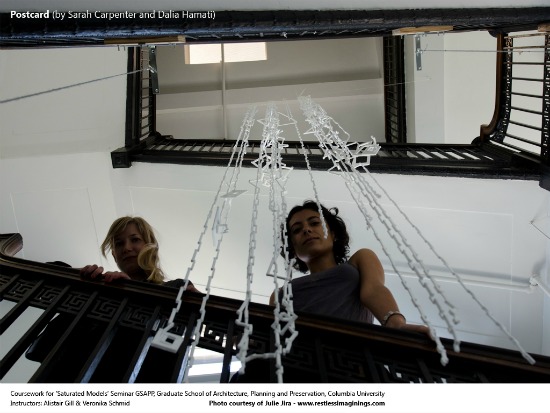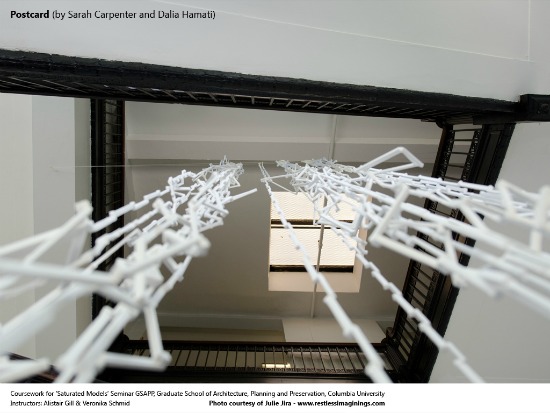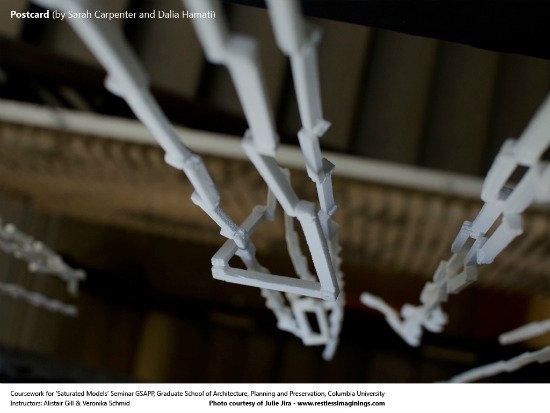Columbia GSAPP Saturated Models 3D printed: Postcard
Alistair Gill and Veronika Schmid held a Saturated Models seminar at Columbia’s Graduate School of Architecture, Planning and Preservation. During the seminar the Master’s students explored 3D printing and created 3D printed objects. i.materialise made the resulting 3D prints. This is the fourth interview with a team of participating architecture students, Sarah Carpenter and Dalia Hamati and their project, ‘Postcard’.
1. Who are you?
We are a pair of architects hailing from Lebanon and the United States. We met at GSAPP and we have a weekly TV watching date. Our future plans may or may not include designing a truck that sells Lebanese street food.
2. What is Postcard?
Postcard is an inquiry into the developing process of 3D printing, and more specifically, into investigating the role of the designer in this process. At the outset the infinite possibilities of 3D printing technology left us scrambling for constraints. Where the designer would have previously used the natural resistance of their material as a guiding force in the design we could have, overwhelmingly, made anything. As it were, we took the physical limitations of the bounding box (20 x 20 x 20cm) and gave ourselves the challenge of creating deep space by yielding as much surface area as possible out of this box. We used the European children’s toy – the ”postcard” – which is essentially a square sheet of paper scored in a coil pattern that, with the pull of gravity, delightfully unfurls into a single long strand. Within the bounding box we were able to print thirty-two coiled strands out of nylon that are hinged at the corners to unravel to a length of 5.5m.
3. Why did you make it?
We were interested in testing the incongruencies between virtual modeling and the physical world, components of which include gravity, sensation, and a dynamic environment. All of these things do not exist in our digital universe of procedures (loft, extrude, join) which have become a language whose consequences we don’t really understand. Our object remains ”function-less” in the traditional sense of the word. It is not programmed to do anything other than exist in the real world.
4. What software did you use to make it?
Rhino, and gmail.
Our model is geometrically very simple, yet it was incredibly laborious to fabricate (thereby inverting our traditional understanding of the relationship between cost and complexity). The exporting procedure of our rhino model was determined by a certain number of kilobytes manageable by our computers. 6000 kilometers away in Belgium the model’s pieces needed to be re-combined, transposed into different software and printed. Inevitably, confusion ensued made all the more complicated by the time difference and conflicting schedules. Miscommunication between the many interfaces and a general lack of material intelligence that arises out of not being able to touch the object on which you work results in a whole lot of emails.
On this point, we think the more interesting question is what ”material” did we use to make it? It can be argued that kilobyte’s, airplanes, emails, software and packing foam all constitute the expanding material sphere of this process of production, and the close relationship between object and maker has been widened to include technicians, pilots, customs officers and sniffing dogs.
5. What was the process by which you came to your design?
Error and failure. We began by using our object to challenge the existing weaknesses of the 3D printing process, however, we quickly realized that it was becoming a vehicle through which to reveal and understand the unforeseen limitations of this technology at this point in time.
6. Will you be using 3D printing more often in the future?
3D printing is only just beginning to move beyond its honeymoon period of spectacular form generation into its awkward teenage phase of testing and failure, so we are only now starting to understand how it performs. We look forward to the expansion of the material sphere from to begin to include building material – concrete, glass. Suddenly all that we have come to associate with the process of making a material such as glass – heating, rolling, tempering and laminating – as well as the material qualities through which we understand it (clear, fragile, planar etc) disintegrate, like the material itself, into a powder form that can be molded into anything. It”s mind-boggling.
Also, we think it”s telling that the formal vocabulary of our object is derived from planar, Cartesian geometry, despite the infinite curves that are now available to us with nurbs and meshes. Subconsciously we still understand a suspended structure to mean long, thin and straight, and for hinges to be two-directional and simple because that is how gravity and physics defined it for us. However, as virtual, gravity-less modeling and 3D printing become more commonplace it will be interesting to observe how this altered vocabulary creates a new language of objects.
7. Are you happy with the result?
Given that our model set out to test the strength of the material under the pull of gravity we were surprised that it was able to do so, and to do so well! The hinges (merely 1.5mm in diameter!) carry significant weight when the model is suspended, especially at the top. Each joint simultaneously represents the opportunity for excess and the likelihood of failure. We really weren’t sure until we pulled the model out of the box whether it would break into a thousand pieces or not; the fact that it didn’t is quite amazing and speaks the potential of the technology. I think the technicians were more surprised than anyone. Hopefully future designers will be able to learn from the results of this experiment – we are happy to contribute to the ongoing development of this fascinating technology.
Recommended Articles
No related posts.





